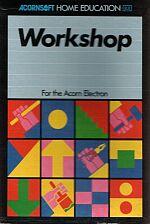
A&B Computing
 1st February 1985
1st February 1985
Author: Mike Williams
Publisher: Acornsoft
Machine: Acorn Electron
Published in A&B Computing 2.03
The cries have almost inevitably begun to go out recently about the disappointing progress made in the field of educational software. A figure of 3.6 million has been put on the financial backing for microcomputer (almost entirely BBC) hardware in the Trade and Industry department scheme. But where's the software? the critics have started to shout.
Software of all standards takes time to develop and software of high quality needs field testing, revising, discussion between educationalists, programmers and publishers. And now perhaps the benefits of hard work and long hours is beginning to pay off. Experience of using micros with young children is beginning to show through in the new generation of programs.
Acornsoft's Workshop is one of these, suitable for home use or in the classroom, suitable for the individual child or for a bunch of children each contributing an idea in turn. Workshop is about investigation and experimentation.

The child is offered the opportunity of controlling a workshop full of interesting tools. Large colourful symbols represent the actions for paint, drill, scale, cut, squash, glue, rotate and look. The symbol for a shelf completes the function key strip which accompanies the program and makes selection dead easy.
The shelf page offers the choice of circle, square or triangle. Simply learned combinations of keys like DELETE, RETURN, COPY and numbers 0 to 4 do all the swapping, cancelling and confirming required at this stage. The basic shape which has been selected is now ready for the machines!
The plan page displays the symbols for the machines (glue, drill, etc) with the chosen shape in the main central box. The child can move the shape around the box and rotate it (in 90 degree chunks). When satisfied with the results the function keys move us on to the machines. Each machine has its own page.

At this point I must explain that every action taken by the child is being recorded by the computer. Each move is taking its place in a sort of program which can later be played back. This program can be viewed by moving to the look page. It's displayed as a series of machine symbols. Exciting, isn't it?
The best bit is to come. The drill cuts ever-increasing bits out of your shape. With cut, you choose the side of the shape you wish to lose and it is sliced off. Paint lets you recolour in any of the seven Mode 2 colours available after black background. Usually the DELETE key undos the lasts action, but on the paint page it undid them all and returned to the original colour of the shape.
The squash page also encompasses stretch. Select with cursor keys, up for stretch, down for squash and hey presto. All actions are accompanied by wonderfully appropriate noises (It's OK Des, they can be switched off!)
Glue shifts the shape sideways onto a new one and sticks them together. Fascinating. Scale is for bigger or smaller shapes. If you increase the size it tends to reduce back to its original shape. If you reduce, it is possible to reduce beyond the ability to reproduce the original. Increase again and you have a new, simplified shape.
Workshop is about play and experiment. There's no telling what you could find out, what shapes you could come up with. The "Not" page creates a shape in your box where once there was space and vice versa.
From the look page, all your actions can be replayed. A strange compilation sequence ensues followed by the replay in full. The program can now be deleted, but the shape you have created remains on the shelf, ready for further machining.
The manual which accompanies Workshop is brief and to the point. It does not need to explain keypresses because the choices are always on screen - for intelligent guessing and experiment if you don't know what they do. DELETE and RETURN are consistently used for Cancel/Confirm. There are some great sounds, high pitched squeaks and a very sonorous clang when you drop a clanger!
Workshop is real value for money educational software since its open ended nature will provide inspiration for children year after year. It offers an exciting opportunity for children to build and control a creative process and to observe it in action when they are satisfied with the job. It's one of many programs now answering the critics with imaginative and inspiring ideas, well implemented.











